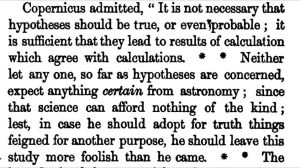As we can see, Copernicus had some interesting opinions on the scientific method.
Reality is not important. Just lay down a nice hypothesis and say: ‘you can’t prove yours and I can’t prove mine, therefore both are equally valid’.
This is the essence of Kabbalistic thought, upon which the powerful build their solipsism. This is the foundational thought of magick, where ‘truth’ becomes a personal experience.
This is how they manipulate not reality itself, but our perception of it.
However, we have a useful tool in these matters: Occam’s razor, which states that when faced with choice, the simplest one is usually the best.
And it’s clear that both at the time and today, Occam’s razor gives clear preference to Tychonic Geocentrism and not to Heliocentrism, which cannot explain why we are not observing stellar parallax.
These quotes are really very telling about a man who is known to have been heavily involved in groups around Platonic mysticism in Bologna. Plato had maintained the Sun was the most exalted in the observable world.
Wrote Copernicus:
“In the middle of all sits Sun enthroned. In this most beautiful temple could we place this luminary in any better position from which he can illuminate the whole at once? He is rightly called the Lamp, the Mind, the Ruler of the Universe….”
As we can see, it’s rather one sided to blame Catholics, Protestants and ‘Bible Believers’ for a religious agenda behind Geocentrism.
Because the ‘spiritual’ agenda behind Heliocentrism is quite blatant and comparing both camps it is clear that the X-tians have shown a great deal more respect for the scientific method than the Sun worshippers of Heliocentrism.
Let alone Tycho Brahe, who was a great and impeccable scientist who showed proper respect for the observable data and restraint in coming to conclusions.
Related:
Heliocentrism Is Dead. There Is No Stellar Parallax!



Tycho Brahe and Longomontanus were indeed on the right track – and were only missing a few pieces of the puzzle. I believe to have found those pieces. In their days, of course, neither of them knew that the overwhelming majority of our visible stars are ‘locked’ in binary systems (as we know today, over 85% …and counting). It thus stands to reason that our solar system is no different – or it would be an anomalous, one-of-a-kind “exception to the rule”… Kepler also came tantalizingly close to resolving the cosmic puzzle as he desperately struggled to wrap his head around Mars’s baffling trajectories (i.e. when he drew his pretty “pretzel” diagram). Ironically, Kepler famously stated that “Mars is the key to understanding the solar system”. Alas, he ultimately failed to find that key – and resorted to “mathemagicks” to make Mars fit into the geometrically-flawed Copernican heliocentric hypothesis.
In short, we live at the barycenter of a classic binary system composed of the Sun and its tiny companion, Mars (Mercury & Venus are logically the Sun’s two moons – much like Phobos & Deimos are the moons of Mars). And no, Mars is not “far too small” to be the Sun’s companion : for instance, the two components of the Sirius binary system (Sirius A and Sirius B) are proportionally near-identical to the Sun and Mars. This is empirical evidence that such highly unequally-sized bodies can be binary companions.
I expound my findings in this recently released study titled “The TYCHOS – our geoaxial binary system” (March 21, 2018) : http://www.tychos.info
I would be delighted if the learned author and readers of this fine blog would take the time to review my work. So far, I’ve had precious little feedback from the world’s scientific community – perhaps unsurprisingly so.
with cosmic regards
Simon Shack
LikeLike